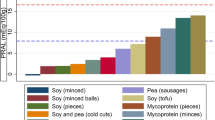Abstract
IN previous investigations it has been shown that free taurine is present in the tissues of both invertebrate and vertebrate species1,2. However, published taurine analyses of specific food items or animal tissues, used as food, have been extremely limited3,4. Various reasons may be put forward to account for this lack of information. First, in man, taurine has not been shown to have an active function, other than that of conjugation with bile-acids5. Secondly, more than forty years ago, Schmidt showed that the oral administration of taurine to human subjects resulted in the prompt urinary excretion of 60–87 per cent of the taurine sulphur in the organic form. It was presumed that the organic sulphur-containing constituent in the urine was free taurine6. Thirdly, until this investigation, the only reported toxic effect of taurine occurred in rabbits; while in man and other animals it has been shown to be non-toxic even in high dosage7,8.
This is a preview of subscription content, access via your institution
Access options
Subscribe to this journal
Receive 51 print issues and online access
$199.00 per year
only $3.90 per issue
Buy this article
- Purchase on Springer Link
- Instant access to full article PDF
Prices may be subject to local taxes which are calculated during checkout
Similar content being viewed by others
References
Schmidt, C. L. A., and Watson, T., J. Biol. Chem., 33, 499 (1918).
Dziewiatowsky, D. D., Sulfur, in Mineral Metabolism, 2, Part B, edit. by Comar, C. L., and Bronner, F. (Academic Press, New York and London, 1962).
Awapara, J., J. Biol. Chem., 218, 571 (1956).
Armstrong, M. D., and Yates, K. N., Proc. Soc. Exp. Biol. and Med., 113, 680 (1963).
Sjovall, J., Proc. Soc. Exp. Biol. and Med., 100, 676 (1957).
Schmidt, C. L. A., von Adelung, E., and Watson, T., J. Biol. Chem., 33, 510 (1918).
Salkowski, E., Arch. path. Anat. Physiol., 58, 1 (1873).
Eldjarn, L., Scand. J. Clin. and Lab. Invest., 6, Suppl. 13, 18 (1954).
Virtue, R. W., and Doster-Virtue, M. E., J. Biol. Chem., 119, 697 (1937).
Garvin, J. E., Arch. Biochem., 91, 219 (1960).
Sörbo, B., Clin. Chim. Acta, 6, 87 (1961).
De Ropp, R. S., and Snedeker, E. H., Anal. Biochem., 1, 424 (1960).
Curzon, G., and Giltrow, J., Nature, 173, 314 (1954).
Jones, N. R., Biochem. J., 56, xxii (1954).
Lewis, P. R., Biochem. J., 52, 330 (1952).
van Thoai, N., and Roche, J., Ann. New York Acad. Sci., 90, 923 (1960).
Koechlin, B. A., J. Biophys. Biochem. Cytol., 1, 511 (1955).
Read, W. O., and Welty, J. D., J. Biol. Chem., 237, 1521 (1962).
Read, W. O., and Welty, J. D., J. Pharmacol. and Exp. Therapeut., 139, 283 (1963).
Martin, W. G., and Patrick, H., Poultry Sci., 40, 267 (1961).
Author information
Authors and Affiliations
Rights and permissions
About this article
Cite this article
ROE, D., WESTON, M. Potential Significance of Free Taurine in the Diet. Nature 205, 287–288 (1965). https://doi.org/10.1038/205287a0
Issue Date:
DOI: https://doi.org/10.1038/205287a0
This article is cited by
-
Retention of health-related beneficial components during household preparation of selenium-enriched African catfish (Clarias gariepinus) fillets
European Food Research and Technology (2008)
-
Neutrophil taurine in psoriasis
Irish Journal of Medical Science (1996)
-
Determinations of taurine in milk and infant formula diets
European Journal of Pediatrics (1984)
-
Taurine and Psoriasis**From the Department of Dermatology, Stanford University School of Medicine, Palo Alto, California.
Journal of Investigative Dermatology (1968)
-
The Biology of Psoriasis
Journal of Investigative Dermatology (1967)
Comments
By submitting a comment you agree to abide by our Terms and Community Guidelines. If you find something abusive or that does not comply with our terms or guidelines please flag it as inappropriate.



